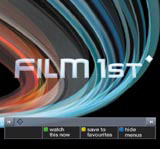TV sets appetising menu
Technology is now enabling interactive TV providers to develop sophisticated on-screen services with fast, intuitive interfaces. Scott Billings tunes in

On-screen design is finally coming of age, thanks to ongoing developments in digital broadcasting technology. Opportunities are opening up for designers to adopt creative visual and brand elements, in areas such as on-screen guides and interactive services, in a way that has so far been prohibited by technological restraints.
The days of the clunky graphics of Ceefax and Oracle are fast receding, as electronic programme guides and interactive portals employ richer visuals and easily navigable systems. Advances in the economy of bandwidth – the space given to the transfer of audio-visual data – are helping previously text-based systems to come alive with full-motion video, branding and coherent style palettes.
In this vein, BSkyB is poised to unveil a substantially overhauled interactive service, Sky Active (see News, page 4). Led by Sky Interactive operations and design director Gerry O’Sullivan, a 40-strong design and development team has put together what is currently the most advanced interactive TV system in the world. Last month it announced a partnership with D&AD to promote high standards of creative achievement in interactive television.
‘We are designing for usability and for TV, where the expectation is so high,’ says O’Sullivan. ‘Viewers expect high quality broadcast graphics [in interactive elements] because that’s what they see everywhere else on the TV.’
O’Sullivan acknowledges that the current Sky Active zone, like all interactive systems, has a very electronic look, relying primarily on text menus and lists. ‘We wanted to achieve the personality and engagement that you get with broadcast, but for it to load quickly,’ he says.
Speed is very much the Holy Grail here. According to Christian Ruland, interactive design creative director at BBC Broadcast, the restrictions on what is possible creatively are imposed by the cost of the bandwidth needed to deliver content to viewers’ homes.
‘With current technology, in theory almost anything is possible, but the restriction is bandwidth, as people don’t want to wait for lots of graphics to load. It depends how much a channel wants to spend on its interactive elements; it comes down to a business model really,’ says Ruland.
But it is not simply about being pretty. Achieving clear and consistent navigation through on-screen areas is a key challenge for designers of interactive systems. The forthcoming Sky Active system, for example, ensures that a global navigation pop-up menu is available from anywhere in the portal.
Marco Giusti, creative director at broadband and on-demand TV service HomeChoice, is also acutely aware that a badly structured navigation system can affect the user’s experience. ‘It is very important that the viewing is not interrupted – no matter how many buttons are pressed – until a final decision is made,’ explains Giusti. In this way, all the HomeChoice menus may be navigated, but the current channel will be shown on-screen until a command is given to change sections.
HomeChoice has also introduced an extra level of interaction between hardware and on-screen elements. When using a specially designed remote control for children, dubbed the minimote (DW 16 September), the HomeChoice set-top box automatically filters out all non-children’s channels.
According to Marcus Jones, partner at screen specialist Dunning Eley Jones, the current trend in navigation is towards a pared- down system that relies on the four arrow buttons and an ‘enter’ button, common features on most remote controls.
‘It’s about recognising intuitive behaviour. A lot of elements have been developed from research into the use of other media, particularly mobile phones,’ he says. ‘It’s all very well designing things that look great, but it falls at the first hurdle if you give it to someone else and they can’t use it.’
Bruce Chaney, head of service excellence at Telewest Broadband, thinks simplicity is paramount. ‘Telewest strives to achieve a simple, fast and stable interactive TV experience. We do not compartmentalise any of the interactions such as changing channel. Instead, we endeavour to apply the same concepts to all, to create a seamless environment.’
Designers of on-screen guides and portals must also deal with issues of branding. For example, should each channel brand be allowed its own style in a given area, or should it merely use a ‘rubber stamp’ of its logo? To maintain a coherent visual palette, can individual channel brands sit harmoniously alongside the ‘parent’ branding of the guide?
‘We considered which areas should follow HomeChoice branding and which should display the original brands,’ says Giusti. Many areas of the HomeChoice system adopt a co-branding strategy, where the channel logos are displayed within a HomeChoice-style EPG.
The new Sky Active system feels like a cross between a magazine, the Internet and TV. A central portal area incorporates a 16-square mosaic of individual ‘broadcast’ channels. Thanks to reductions on data size at the broadcast and development stages, all 16 ‘screens’ consume the bandwidth of less than one channel, according to O’Sullivan.
This ability to deliver richer content across the same bandwidth is unlocking a range of possibilities for designers. ‘Interactivity has so far been pretty unsophisticated. The audience, which has been experiencing full branding on television, has not been seeing it in interactive services.
‘Now we have to let our design team loose. The styling is televisual – forget the set-top box restrictions and the flat blue background,’ concludes O’Sullivan.
-
Post a comment




